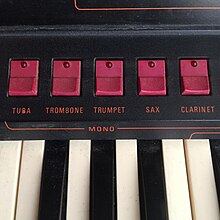Farfisa Soundmaker
| synthesizer | |
|---|---|

|
|
| General | |
| Surname | Farfisa Soundmaker |
| Manufacturer | Farfisa |
| Sound synthesis | analog, subtractive |
| Period | 1979-1981 |
| properties | |
| Polyphonic | polyphonic and monophonic |
| Multitimbral | yes, triple |
| Keys | 61 keys |
| Effects | Vibrato , portamento and pitch |
The Farfisa Soundmaker is an analog, monophonic (but partly polyphonic ) synthesizer from the Italian organ manufacturer Farfisa . It was introduced in 1979 and is to be regarded as an indirect successor to the Farfisa Syntorchestra .
General
The Soundmaker has 61 keys in its keyboard and therefore covers five complete octaves including C of the sixth octave.
You can choose between polyphonic and monophonic registers. A combination of these is also possible - the keyboard can be "split" in the middle. Polyphonic chords can be played with the right hand and the melody with the left hand.
The Soundmaker also has five poly registers ( piano , harpsichord , honky-tonk piano, brass and brass with vibrato ), an external string ensemble typical of the time , which is also polyphonic, and a total of twelve monophonic sounds ( tuba , trombone , Trumpet , saxophone , clarinet , oboe , flute , piccolo , accordion , electric bass and electric guitar ). All registers can be easily changed and adjusted with the synthesizer elements on the front of the instrument.
In addition, the instrument has a mode in which no preset is activated and the musician can create, save and recall his own sound. However, the technology of the soundmaker is very limited in this regard and is not designed around this function, in contrast to the leading synthesizers of this time ( Moog Minimoog Voyager , Sequential Circuits Prophet-6 etc.).
The synthesizer has two 6,35mm- jacks , one for the polyphonic and monophonic section, as well as a headphone output and an input jack. External noise sources could be integrated into the soundmaker's technology . Although these could not be remotely controlled ( MIDI ), they could be output. When working with another instrument, only a single pair of headphones was required, which was clipped to the sound maker .
Others
Like the Syntorchestra, the instrument was designed to accompany the electronic organs customary at the time and designed so that it could be placed on top of the organ cladding. In contrast to the aforementioned instrument, the housing of all models was made of wood and no version with metal cladding was offered.
The Soundmaker enjoys a certain rarity status and is now only to be found among collectors. It was produced in a very small number of just 100 copies, not least because it weighed over 27 kg and was therefore not selling well - the market for home organs was also on the verge of collapse in the late 1970s.
